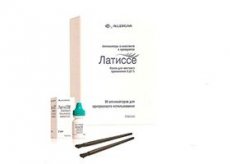Medical expert of the article
New publications
Preparations
Latisse
Last reviewed: 03.07.2025

All iLive content is medically reviewed or fact checked to ensure as much factual accuracy as possible.
We have strict sourcing guidelines and only link to reputable media sites, academic research institutions and, whenever possible, medically peer reviewed studies. Note that the numbers in parentheses ([1], [2], etc.) are clickable links to these studies.
If you feel that any of our content is inaccurate, out-of-date, or otherwise questionable, please select it and press Ctrl + Enter.

Latisse is an analogue of the element PG. It is used to eliminate hypotrichosis.
 [ 1 ]
[ 1 ]
Indications Latisse
It is used to eliminate ciliary hypotrichosis (poor eyelash growth).
Release form
The product is released in the form of drops placed in 3 ml dropper bottles. The package contains 1 bottle, as well as special applicators (60 pieces).
Pharmacodynamics
The component bimatoprost is a structural analogue of the component PG. It is not known how the drug works, but there are suggestions that eyelash growth is achieved by increasing their number, and in addition, by prolonging the stage of hair follicle growth or the stage of eyelash growth.
Pharmacokinetics
After using the drug in a drop form with a concentration of 0.03%, peak plasma levels are observed after 10 minutes, and after 1.5 hours they decrease to a minimum level (0.025 ng / ml). The average level of peak plasma indicators and AUC values by the 7th and 14th day of using the drug was approximately the same (respectively, 0.08 and 0.09 ng × h / ml). Significant systemic accumulation of the substance was not detected.
The active ingredient is distributed within the tissues, and the equilibrium level of the distribution volume is 0.67 l/kg. In the blood plasma, bimatoprost is mainly contained in the form of synthesized with protein. Only 12% of the substance remains free within the circulatory system. Most of the bimatoprost enters the bloodstream unchanged. Then, the processes of ethylation, oxidation, and glucuronidation occur, resulting in the formation of various decay products.
During intravenous administration of 3.12 mg/kg to 6 volunteers, the peak plasma concentration was 12.2 ng/ml. The half-life of the component was approximately 45 minutes. The total clearance rate of the drug was 1.5 l/hour/kg.
Approximately 67% of the drug is excreted through the kidneys, and another 25% through the gastrointestinal tract.
Dosing and administration
The drops are used once a day - before going to bed. Before this, you need to remove decorative cosmetics from your face and take out contact lenses (if any). You need to drop 1 drop of the drug on a special applicator, and then evenly treat the skin along the border of eyelash growth on the upper eyelid - you need to move the applicator along its edge.
The upper eyelid should be moistened only slightly at the place of eyelash growth, and the medicine should not flow beyond the boundaries of this line. To avoid excessive moistening, it is necessary to remove excess medicine. The used applicator is immediately thrown away, it is prohibited to use it again. To treat the second eyelid, you need to take a new applicator.
When applying Latisse, it is forbidden to use other applicators (not those included in the medicine package) or a brush. It is also forbidden to treat the lower eyelids with the product. In addition, you need to ensure that the dropper of the bottle with drops does not come into contact with any surfaces - so that no infection gets on it.
Use Latisse during pregnancy
Animal tests have examined oral administration of bimatoprost in doses 33-97 times higher than those recommended for topical use. In such experiments, animals suffered miscarriages. After using the substance in a dose 41 times higher than the medicinal dose, a reduction in the gestation period, an increase in the incidence of fetal death, and a decrease in the weight of newborns were observed.
Controlled trials of Latisse drops in pregnancy have not been performed.
Animal tests have also confirmed that bimatoprost is able to pass into breast milk. Therefore, during the period of using the drug, it is necessary to stop breastfeeding.
Contraindications
Main contraindications: children under 18 years of age, and also the presence of intolerance to medicinal components.
Caution is required when using in people with aphakia or pseudoaphakia, as well as with damage to the posterior lens capsule. In addition, caution should be exercised in patients with long-term diabetes, high risk of macular edema, high blood pressure (especially if high diastolic pressure values are observed), high cholesterol, nephropathy, and uveitis (because this disease may progress in this case).
Special instructions
Reviews
Latisse greatly promotes eyelash growth, giving high efficiency, but it is noted that when you stop using the drug, the eyelashes fall out and return to their original appearance. Also in the reviews it is indicated that the drug is quite expensive.
 [ 12 ]
[ 12 ]
Shelf life
Latisse is allowed to be used for a period of 2 years from the date of manufacture of the medicinal product.
Attention!
To simplify the perception of information, this instruction for use of the drug "Latisse" translated and presented in a special form on the basis of the official instructions for medical use of the drug. Before use read the annotation that came directly to medicines.
Description provided for informational purposes and is not a guide to self-healing. The need for this drug, the purpose of the treatment regimen, methods and dose of the drug is determined solely by the attending physician. Self-medication is dangerous for your health.

